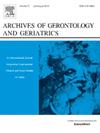年龄对突发性感音神经性听力损失(SSNHL)后听力结局的影响:一项回顾性研究
IF 3.8
3区 医学
Q2 GERIATRICS & GERONTOLOGY
引用次数: 0
摘要
目的分析年龄对突发性感音神经性听力损失(SSNHL)治疗后听力结局的影响。材料和方法本回顾性研究回顾了106例SSNHL患者的记录,分为年轻(65岁)和老年(≥65岁)。听力结果和相关因素包括性别、绝对增益、治疗时间、高压氧治疗(HBOT)、听图类型和对侧耳阈值。结果年龄组间治疗效果无统计学差异(p = 0.053),但年龄越小,恢复越好。年龄与绝对听力增加呈显著负相关(r = -0.296, p <;0.05)。与年轻男性相比,年轻女性表现出更好的结果(p <;0.05)。早期治疗预后较好(χ²= 9.04,p <;0.01)。正常的对侧耳阈值与较好的恢复相关(p <;0.05)。建立多元logistic回归模型(AUC = 0.781)。症状持续时间(p <;0.05)和腔内治疗(p <;0.05)是听力结局的显著预测因子。年龄不是显著的独立预测因子(p = 0.054),但它改善了模型拟合,支持其临床相关性。结论开始治疗的时机对SSNHL的预后有重要影响。虽然年龄在多变量模型中没有达到统计学意义,但它与更好的结果和对模型拟合的贡献的一致关联突出了其持续的临床相关性。早期干预是恢复的关键预测因素,加强了年龄知情的个性化治疗策略在管理SSNHL中的价值。本文章由计算机程序翻译,如有差异,请以英文原文为准。
The effect of aging on hearing outcomes after sudden sensorineural hearing loss (SSNHL): A retrospective study
Objectives
To analyze the effect of aging on hearing outcomes following treatment for sudden sensorineural hearing loss (SSNHL).
Materials and methods
This retrospective study reviewed records of 106 SSNHL patients categorized into younger (<65 years) and older (≥65 years). Hearing outcomes and related factors including sex, absolute gain, treatment timing, Hyperbaric Oxygen Therapy (HBOT), audiogram type, and contralateral ear thresholds were examined.
Results
Treatment outcomes between age groups showed no statistically significant difference (p = 0.053), though younger age was consistently linked to better recovery. A significant negative correlation between age and absolute hearing gain was observed (r = -0.296, p < 0.05). Younger females showed superior outcomes compared to younger males (p < 0.05). Early treatment predicted better recovery (χ² = 9.04, p < 0.01). A normal contralateral ear threshold was associated with better recovery (p < 0.05). A multivariate logistic regression model was developed (AUC = 0.781). Symptom duration (p < 0.05) and intratympanic therapy (p < 0.05) were significant predictors of hearing outcomes. Age was not a significant independent predictor (p = 0.054), but it improved model fit, supporting its clinical relevance.
Conclusions
The timing of treatment initiation is important for SSNHL prognosis. Although age did not reach statistical significance in the multivariate model, its consistent association with better outcomes and contribution to model fit highlight its continued clinical relevance. Early intervention is the key predictor of recovery, reinforcing the value of age-informed, personalized treatment strategies in managing SSNHL.
求助全文
通过发布文献求助,成功后即可免费获取论文全文。
去求助
来源期刊
CiteScore
7.30
自引率
5.00%
发文量
198
审稿时长
16 days
期刊介绍:
Archives of Gerontology and Geriatrics provides a medium for the publication of papers from the fields of experimental gerontology and clinical and social geriatrics. The principal aim of the journal is to facilitate the exchange of information between specialists in these three fields of gerontological research. Experimental papers dealing with the basic mechanisms of aging at molecular, cellular, tissue or organ levels will be published.
Clinical papers will be accepted if they provide sufficiently new information or are of fundamental importance for the knowledge of human aging. Purely descriptive clinical papers will be accepted only if the results permit further interpretation. Papers dealing with anti-aging pharmacological preparations in humans are welcome. Papers on the social aspects of geriatrics will be accepted if they are of general interest regarding the epidemiology of aging and the efficiency and working methods of the social organizations for the health care of the elderly.

 求助内容:
求助内容: 应助结果提醒方式:
应助结果提醒方式:


